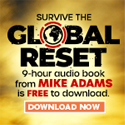
American Medical Association Promoted Tobacco, Cigarettes in its Medical Journal
 Friday, June 12, 2009 Friday, June 12, 2009by Mike Adams, the Health Ranger Editor of NaturalNews.com (See all articles...) Tags: JAMA, health news, Natural News |
- Newly released JFK files reveal Pentagon's role in creating Lyme disease and covid in the same lab
- Trump nominates VACCINE ZEALOT Susan Monarez to lead the CDC, sidelining RFK Jr.'s reform efforts
- BEWARE: USDA allows genetically engineered vaccines to infiltrate organic food production
- Obama accused of laundering USAID funds to fuel global protest movements, regime change operations
- Festive flavors: The sweet history, nutritional profile and health benefits of pecan pie
- Dr. Mike Yeadon releases 15-minute testimony - WATCH - about genocidal intent of COVID “vaccines”
- Big Pharma's media takeover: How drug companies bought the news - and your health
- Analysis: The coming economic collapse, a mass uprising and Trump's three secret weapons to halt the growing revolt
- Elon Musk: Aliens could be here on Earth RIGHT NOW
- Trump reverses course on Gaza plan, says “nobody is expelling Palestinians”
- Survival 101: Effective EMF blocking techniques
- Reclaim your health: How midlife exercise reverses years of inactivity
- Big Pharma's $8 Billion bribery scheme exposed: how doctors are pushed to prescribe junk science, not heal
- HUGE: Putin claims 2020 election fraud in U.S. sparked Ukraine war, calls for peace talks with Trump
- California's social media censorship law struck down: A victory for free speech or a threat to online safety?
- Rep. Nancy Mace introduces bill to ban biological males from female facilities on federal property
- Chris Rufo finally reveals abuse liberals unleashed on his wife and young kids...
- RFK Jr.'s SSRI antidepressant investigation sparks liberal meltdown, exposes Big Pharma's dangerous game
- Elon Musk: Aliens could be here on Earth RIGHT NOW
- EPA advisor admits the agency is funneling billions to climate groups ahead of Trump’s return to White House
- Trump reverses course on Gaza plan, says “nobody is expelling Palestinians”
- Reclaim your health: How midlife exercise reverses years of inactivity
- A lack of integrity in Academia: Harvard professor found GUILTY of fraudulent research to promote CRT theory
- Space war brewing? Russia threatens to destroy Starlink satellites
- Big Pharma's $8 Billion bribery scheme exposed: how doctors are pushed to prescribe junk science, not heal
- Mike Adams Sermon 66: God will DESTROY ISRAEL for its wickedness
- Rep. Nancy Mace introduces bill to ban biological males from female facilities on federal property
- Survival 101: Effective EMF blocking techniques
- 5 Simple steps to boost your brainpower: How to strengthen executive function in a distracted world
- Historian warns Israel may be entering an “IRREMEDIABLE DECLINE”
- Florida takes a stand: DeSantis proposes permanent ban on mRNA vaccine mandates
- RFK Jr.'s SSRI antidepressant investigation sparks liberal meltdown, exposes Big Pharma's dangerous game
- New York politicians push bill allowing governor to indefinitely detain the unvaccinated on a whim
- Sales of survival bunkers rise following Russia’s use of the Oreshnik hypersonic ballistic missile
- Pilots report mysterious lights 'moving at extreme speeds' across Oregon skies
- Newly released JFK files reveal Pentagon's role in creating Lyme disease and covid in the same lab
- EPA advisor admits the agency is funneling billions to climate groups ahead of Trump’s return to White House
- The Health Ranger releases “Vaccine Zombie” song and music video, using AI-animated zombies for the music video
- The pandemic as a tool for INDOCTRINATION: Understanding “The Indoctrinated Brain” by Dr. Michael Nehls
- California's social media censorship law struck down: A victory for free speech or a threat to online safety?
- Dr. Mike Yeadon releases 15-minute testimony - WATCH - about genocidal intent of COVID “vaccines”
- Congratulations to the FULLY UNVACCINATED as you resisted the COVID-19 PROPAGANDA MACHINE fueled by over $100 BILLION
- Mike Adams releases country western hit single: Goin’ Back in Time is Comin’ Home
- RFK Jr. clears key hurdle: Sen. Susan Collins backs controversial HHS nominee, signaling a new era for health policy
- Mike Adams releases music poetry sensation: A Child of God
- Mike Adams releases new song and music video: Nothing More Disgusting Than a Globalist
- Unpacking the Lies That We’ve Been Fed – new song and music video released by Mike Adams, the Health Ranger
- Trump administration takes on global censorship: A new frontier for free speech advocacy
- Florida takes a stand: DeSantis proposes permanent ban on mRNA vaccine mandates
- “Why we influenced the 2020 elections”: Facebook files reveal the coordinated effort to bury the Hunter Biden laptop story
- Ex-FBI Chief EXPOSES disgraceful government coverups of Oklahoma City Bombing, Kennedy assassinations, 9/11 WTC, and "Terrorism" as plot to destroy Constitution
- Michigan sheriff announces criminal investigation into 2020 election crimes, Dominion Voting Systems
- Israeli soldiers accused of even more torture and abuse in the West Bank
- Federal judge backs Trump's mass firings, clearing path for government downsizing
- Red Cross issues warning to stop blood plasma donations from vaccinated people
- Scientists confirm: GENIUS brain function can be spontaneously unleashed in humans without any apparent cause
- EPA advisor admits the agency is funneling billions to climate groups ahead of Trump’s return to White House
- HYSSOP: What research reveals about the health benefits of this ancient holy herb
- Two containers with completed ballots fall out of truck in Florida
- Fully vaccinated about to see “tsunami” of illness and death, warns virologist
- Today I asked our AI language model “Neo” about which phytonutrients or phytochemicals can block the spike protein related to SARS-CoV-2 … Here is what it answered…
- Global leaders unite to clamp down on “misinformation” with UN-backed Cascais Declaration
- BREAKING: 2025 NDAA authorizes mandatory military draft of WOMEN across America… as Pentagon pursues global NUCLEAR war with both Russia and China at the same time
- Michael Yon warns of a ZIONIST TAKEOVER in Trump’s second administration
- BOMBSHELL: DNA testing kits are a SCAM to develop ethnic-specific bioweapons
- Ozempic and Wegovy weight loss drugs are injectable LIZARD VENOM PEPTIDES that may unleash a devastating wave of organ failure… side effects align with symptoms of SNAKE BITES
- Israeli soldiers accused of even more torture and abuse in the West Bank
- These 13 countries just signed an agreement to engineer a global FAMINE by destroying food supply
- NASA admits that climate change occurs because of changes in Earth’s solar orbit, and NOT because of SUVs and fossil fuels
- RFK Jr. clears key hurdle: Sen. Susan Collins backs controversial HHS nominee, signaling a new era for health policy
- Sermon 30: How Jesus reveals Caesar’s FAKE CURRENCY and FALSE AUTHORITY
- Coriander seeds: Ancient medicine backed by modern science
Despite its stated mission, "To promote the art and science of medicine and the betterment of public health," the American Medical Association (AMA) has taken many missteps in protecting the health of the American people. One of the most striking examples is the AMA's long-term relationship with the tobacco industry.
Both the AMA and individual doctors sided with big tobacco for decades after the deleterious effects of smoking were proven. Medical historians have tracked this relationship in great detail, examining internal documents from tobacco companies and their legal counsel and public relations advisers. The overarching theme of big tobacco's efforts was to keep alive the appearance of a "debate" or "controversy" of the health effects of cigarette smoking.
The first research to make a statistical correlation between cancer and smoking was published in 1930 in Cologne, Germany. In 1938, Dr. Raymond Pearl of Johns Hopkins University reported that smokers do not live as long as non-smokers. The tobacco industry dismissed these early findings as anecdotal -- but at the same time recruited doctors to endorse cigarettes.
JAMA kicks off two decades of cigarette advertising
The Journal of the American Medical Association (JAMA) published its first cigarette advertisement in 1933, stating that it had done so only "after careful consideration of the extent to which cigarettes were used by physicians in practice." These advertisements continued for 20 years. The same year, Chesterfield began running ads in the New York State Journal of Medicine, with the claim that its cigarettes were "Just as pure as the water you drink... and practically untouched by human hands."In medical journals and in the popular media, one of the most infamous cigarette advertising slogans was associated with the Camel brand: "More doctors smoke Camels than any other cigarette." The campaign began in 1946 and ran for eight years in magazines and on the radio. The ads included this message:
"Family physicians, surgeons, diagnosticians, nose and throat specialists, doctors in every branch of medicine... a total of 113,597 doctors... were asked the question: 'What cigarette do you smoke?' And more of them named Camel as their smoke than any other cigarette! Three independent research groups found this to be a fact. You see, doctors too smoke for pleasure. That full Camel flavor is just as appealing to a doctor's taste as to yours... that marvelous Camel mildness means just as much to his throat as to yours."
Big Tobacco's suppression of scientific evidence
At the same time that JAMA ran cigarette ads, it published in 1950 the first major study to causally link smoking to lung cancer. Morton Levin, then director of Cancer Control for the New York State Department of Health, surveyed patients in Buffalo, N.Y., from 1938 to 1950 and found that smokers were twice as likely to develop lung cancer as non-smokers.Cigarette producers may have hoped that the public would remain unaware of studies published in medical journals. However, the dangers of smoking became widely known in 1952 when Reader's Digest published "Cancer by the Carton," detailing the dangers of cigarettes. Within a year cigarette sales fell for the first time in more than two decades.
The tobacco industry responded swiftly, engaging the medical community in its efforts. The Tobacco Industry Research Committee (TIRC) was formed by U.S. tobacco companies in 1954. By sponsoring "independent" scientific research, the TIRC attempted to keep alive a debate about whether or not cigarettes were harmful.
The industry announced the formation of the TIRC in an advertisement that appeared in The New York Times and 447 other newspapers reaching more than 43 million Americans. The advertisement, titled "A Frank Statement to Cigarette Smokers," read:
"RECENT REPORTS on experiments with mice have given wide publicity to a theory that cigarette smoking is in some way linked with lung cancer in human beings.
Although conducted by doctors of professional standing, these experiments are not regarded as conclusive in the field of cancer research. However, we do not believe that any serious medical research, even though its results are inconclusive should be disregarded or lightly dismissed.
At the same time, we feel it is in the public interest to call attention to the fact that eminent doctors and research scientists have publicly questioned the claimed significance of these experiments.
Distinguished authorities point out:
1. That medical research of recent years indicates many possible causes of lung cancer.
2. That there is no agreement among the authorities regarding what the cause is.
3. That there is no proof that cigarette smoking is one of the causes.
4. That statistics purporting to link cigarette smoking with the disease could apply with equal force to any one of many other aspects of modern life. Indeed the validity of the statistics themselves is questioned by numerous scientists.
We accept an interest in people's heath as a basic responsibility, paramount to every other consideration in our business.
We believe the products we make are not injurious to health.
We always have and always will cooperate closely with those whose task it is to safeguard the public health. For more than 300 years tobacco has given solace, relaxation, and enjoyment to mankind. At one time or another during those years critics have held it responsible for practically every disease of the human body. One by one these charges have been abandoned for lack of evidence.
Regardless of the record of the past, the fact that cigarette smoking today should even be suspected as a cause of a serious disease is a matter of deep concern to us.
Many people have asked us what we are doing to meet the public's concern aroused by the recent reports. Here is the answer:
1. We are pledging aid and assistance to the research effort into all phases of tobacco use and health. This joint financial aid will of course be in addition to what is already being contributed by individual companies.
2. For this purpose we are establishing a joint industry group consisting initially of the undersigned. This group will be known as TOBACCO INDUSTRY RESEARCH COMMITTEE.
3. In charge of the research activities of the Committee will be a scientist of unimpeachable integrity and national repute. In addition there will be an Advisory Board of scientists disinterested in the cigarette industry. A group of distinguished men from medicine, science, and education will be invited to serve on this Board. These scientists will advise the Committee on its research activities.
This statement is being issued because we believe the people are entitled to know where we stand on this matter and what we intend to do about it."
Doctors' involvement in the tobacco deception
The statement -- signed by presidents of major tobacco interests including Phillip Morris, Brown & Williamson, and R.J. Reynolds -- was designed to launch the "controversy" which I mentioned earlier. In fact, there was no controversy. The research results were clear: smoking had been proven harmful -- not just to mice, but to people who had for years been advised that smoking offered health benefits.The TIRC promised to convene "a group of distinguished men from medicine, science, and education" and it did so. Early members of the TIRC's Scientific Advisory Board (SAB) included: McKeen Cattell, PhD, MD, professor of pharmacology from Cornell University Medical College; Julius H. Comroe, Jr., MD, director of the University of California Medical Center's cardiovascular research institute and chairman of University of Pennsylvania Graduate School of Medicine; and Edwin B. Wilson, PhD, LLD, professor of vital statistics, Harvard University.
According to the New York State Archives, the TIRC's functions "included both the funding of research and carrying out public relations activities relating to tobacco and health." Faced with mounting evidence that smoking was harmful, "it became evident that this was not a short-term endeavor, and that it was difficult to manage both scientific research and public relations in one organization. As a result the Tobacco Institute was formed to assume the public relations functions, and the Council for Tobacco Research (CTR) was formed and incorporated to provide funding for scientific research."
Whether or not individual doctors supported smoking, lending their names to the TIRC gave it credibility. The Center for Media and Democracy has reported that many of the scientists who were members of the Scientific Advisory Board privately "disagreed with the tobacco industry's party line." According to the center's website: "In 1987, Dr. Kenneth Warner polled the SAB's 13 current members, asking, 'Do you believe that cigarette smoking causes lung cancer?' Seven of the SAB members refused to answer the question, even after Warner promised individual anonymity. The other six all answered in the affirmative. 'I don't think there's a guy on the [Board] who doesn't believe that cigarette smoking contributes to an increased risk of lung cancer,' one said, adding that the SAB's members were 'terrified' to say so publicly out of fear of involvement in tobacco product liability lawsuits."
If it was fear that kept doctors on board with the TIRC and its renamed version, CTR, it did not stop them from handing out research grants. The Center for Media and Democracy describes some of the early grants: "Research projects attempted to show that both lung cancer and smoking were caused by some other 'third factor,' such as a person's psychological makeup, religion, war experiences or genetic susceptibility. One research project asked whether the handwriting of lung cancer patients can reveal characteristics associated with lung cancer. Another looked for enzyme markers predicting susceptibility to lung cancer."
After three decades, the AMA finally admits smoking is harmful
After the 1964 Surgeon General's landmark report on the dangers of cigarettes, the CTR stepped up its work, providing materials to defend the tobacco industry against litigation. The same year -- three decades after medical research demonstrated the dangers of cigarettes -- the American Medical Association finally issued statement on smoking, calling it "a serious health hazard." It was not until 1998 that the CTR was shut down -- and only after the tobacco industry lost a major court case brought forward by states across the country.Allan M. Brandt, a medical historian at Harvard, writes about the role that medical research played on both sides of the smoking debate in his new book, The Cigarette Century: The Rise, Fall and Deadly Persistence of the Product that Defined America. After reviewing research, court transcripts and previously restricted memoranda from tobacco companies, Brandt summed up the misleading nature of "expert" medical testimony in tobacco litigation: "I was appalled by what the tobacco expert witnesses had written. By asking narrow questions and responding to them with narrow research, they provided precisely the cover the industry sought."
In a recent interview with The New York Times, Brandt acknowledged that his research is a combination of scholarship and health advocacy -- pointing out the means by which the American public was intentionally misled for most of the twentieth century. As Brandt stated, "The stakes are high, and there is much work to be done."
The medical conspiracy continues today
It is my belief that just as private industry and the medical community conspired to deceive the public on tobacco (and thereby profit from the public's ignorance of tobacco's extreme health hazard), the same story is repeating itself today in the cancer industry, the sunscreen industry, and the pharmaceutical industry. In each case, so-called "authoritative" doctors insist that whatever they're pushing is safe for human consumption, and that the public should buy their products without any concern about safety.And yet these industries are much like the tobacco industry in the fact that they primarily seek profits, not health. Medicine today is in the business of making money, and that goal is achieved by selling chemical products to consumers regardless of their safety or efficacy. Big Medicine is the modern version of Big Tobacco, and over the last several decades, the American Medical Association has proudly supported both cigarettes and pharmaceuticals. In my opinion, the AMA is indirectly responsible for the deaths of millions of Americans -- not just from pushing cigarettes but also for continuing to push dangerous pharmaceuticals while discrediting nearly everything in natural medicine or alternative medicine. The AMA is a truly evil organization, in my opinion, that I believe has directly and knowingly contributed to the suffering and death of Americans for more than 75 years. Read my story, What the AMA hopes you never learn about its true history to learn more. In a just society, AMA leaders would be arrested and tried for their crimes against humanity, just as top FDA officials should be.
The cancer industry, similarly, is extremely dangerous to the health and safety of Americans thanks to its outright refusal to support anti-cancer nutrition (vitamin D, broccoli sprouts, spirulina, rainforest herbs, etc.) as well as its refusal to fight for the removal of toxic chemicals from consumer products and the workplace.
In studying the history of product commercialization by medical groups, what we consistently find is a series of cons perpetrated against consumers, masterminded by profit-seeing medical groups that conspire with corporations to maximize profits at the expense of public health. Nothing has changed today, either. The AMA isn't pushing cigarettes anymore, but it's still pushing deadly pharmaceuticals that will one day be regarded as just as senseless as smoking. Let's face it: pharmaceutical medicine is hopelessly outdated, ineffective and dangerous. Nobody intelligent today actually believes that pharmaceuticals help people heal. In fact, the more drugs people take, the worse their health becomes! Modern medicine is actually harmful to patients!
Medical science is slow to change, and slow to give up its closely-guarded (false) beliefs. In time, however, virtually everything now supported by the medical industry (the FDA, AMA, ACS, etc.) will be regarded as insanely harmful to human health. One day, future scientists will look back on medicine today and wonder just how such an industry of evil and greed could have gained so much power and authority. The answer is found in "groupthink" and the strange knack for humans to defer to anyone in an apparent position of authority, regardless of whether such authority is warranted.
JAMA at FETCH.news
Get independent news alerts on natural cures, food lab tests, cannabis medicine, science, robotics, drones, privacy and more.
 About the author:Mike Adams (aka the "Health Ranger") is a best selling author (#1 best selling science book on Amazon.com) and a globally recognized scientific researcher in clean foods. He serves as the founding editor of NaturalNews.com and the lab science director of an internationally accredited (ISO 17025) analytical laboratory known as CWC Labs. There, he was awarded a Certificate of Excellence for achieving extremely high accuracy in the analysis of toxic elements in unknown water samples using ICP-MS instrumentation. Adams is also highly proficient in running liquid chromatography, ion chromatography and mass spectrometry time-of-flight analytical instrumentation.
About the author:Mike Adams (aka the "Health Ranger") is a best selling author (#1 best selling science book on Amazon.com) and a globally recognized scientific researcher in clean foods. He serves as the founding editor of NaturalNews.com and the lab science director of an internationally accredited (ISO 17025) analytical laboratory known as CWC Labs. There, he was awarded a Certificate of Excellence for achieving extremely high accuracy in the analysis of toxic elements in unknown water samples using ICP-MS instrumentation. Adams is also highly proficient in running liquid chromatography, ion chromatography and mass spectrometry time-of-flight analytical instrumentation.
Adams is a person of color whose ancestors include Africans and Native American Indians. He's also of Native American heritage, which he credits as inspiring his "Health Ranger" passion for protecting life and nature against the destruction caused by chemicals, heavy metals and other forms of pollution.
Adams is the founder and publisher of the open source science journal Natural Science Journal, the author of numerous peer-reviewed science papers published by the journal, and the author of the world's first book that published ICP-MS heavy metals analysis results for foods, dietary supplements, pet food, spices and fast food. The book is entitled Food Forensics and is published by BenBella Books.
In his laboratory research, Adams has made numerous food safety breakthroughs such as revealing rice protein products imported from Asia to be contaminated with toxic heavy metals like lead, cadmium and tungsten. Adams was the first food science researcher to document high levels of tungsten in superfoods. He also discovered over 11 ppm lead in imported mangosteen powder, and led an industry-wide voluntary agreement to limit heavy metals in rice protein products.
In addition to his lab work, Adams is also the (non-paid) executive director of the non-profit Consumer Wellness Center (CWC), an organization that redirects 100% of its donations receipts to grant programs that teach children and women how to grow their own food or vastly improve their nutrition. Through the non-profit CWC, Adams also launched Nutrition Rescue, a program that donates essential vitamins to people in need. Click here to see some of the CWC success stories.
With a background in science and software technology, Adams is the original founder of the email newsletter technology company known as Arial Software. Using his technical experience combined with his love for natural health, Adams developed and deployed the content management system currently driving NaturalNews.com. He also engineered the high-level statistical algorithms that power SCIENCE.naturalnews.com, a massive research resource featuring over 10 million scientific studies.
Adams is well known for his incredibly popular consumer activism video blowing the lid on fake blueberries used throughout the food supply. He has also exposed "strange fibers" found in Chicken McNuggets, fake academic credentials of so-called health "gurus," dangerous "detox" products imported as battery acid and sold for oral consumption, fake acai berry scams, the California raw milk raids, the vaccine research fraud revealed by industry whistleblowers and many other topics.
Adams has also helped defend the rights of home gardeners and protect the medical freedom rights of parents. Adams is widely recognized to have made a remarkable global impact on issues like GMOs, vaccines, nutrition therapies, human consciousness.
In addition to his activism, Adams is an accomplished musician who has released over a dozen popular songs covering a variety of activism topics.
Click here to read a more detailed bio on Mike Adams, the Health Ranger, at HealthRanger.com.
Take Action: Support Natural News by linking to this article from your website
Permalink to this article:
Embed article link: (copy HTML code below):
Reprinting this article:
Non-commercial use OK, cite NaturalNews.com with clickable link.
Follow Natural News on Facebook, Twitter, Google Plus, and Pinterest
Science News & Studies
Medicine News and Information
Food News & Studies
Health News & Studies
Herbs News & Information
Pollution News & Studies
Cancer News & Studies
Climate News & Studies
Survival News & Information
Gear News & Information
News covering technology, stocks, hackers, and more



"Big Tech and mainstream media are constantly trying to silence the independent voices that dare to bring you the truth about toxic food ingredients, dangerous medications and the failed, fraudulent science of the profit-driven medical establishment.
Email is one of the best ways to make sure you stay informed, without the censorship of the tech giants (Google, Apple, Facebook, Twitter, YouTube, etc.). Stay informed and you'll even likely learn information that may help save your own life."
–The Health Ranger, Mike Adams













































